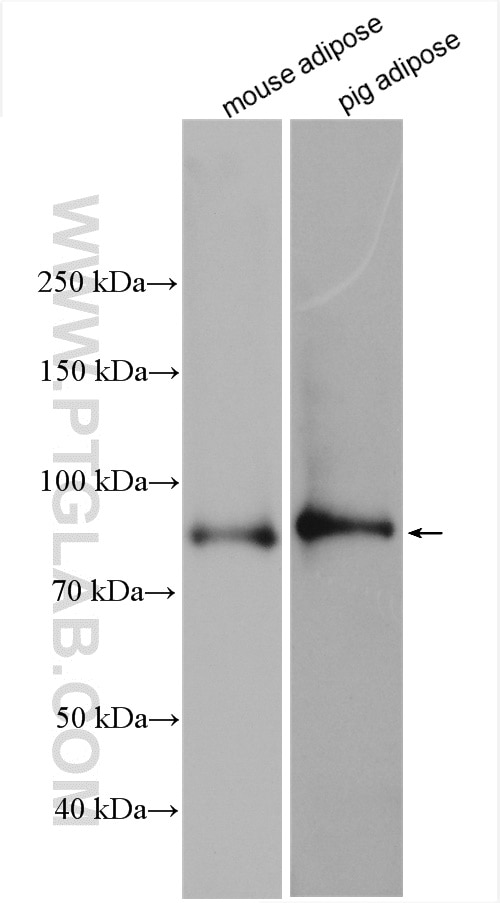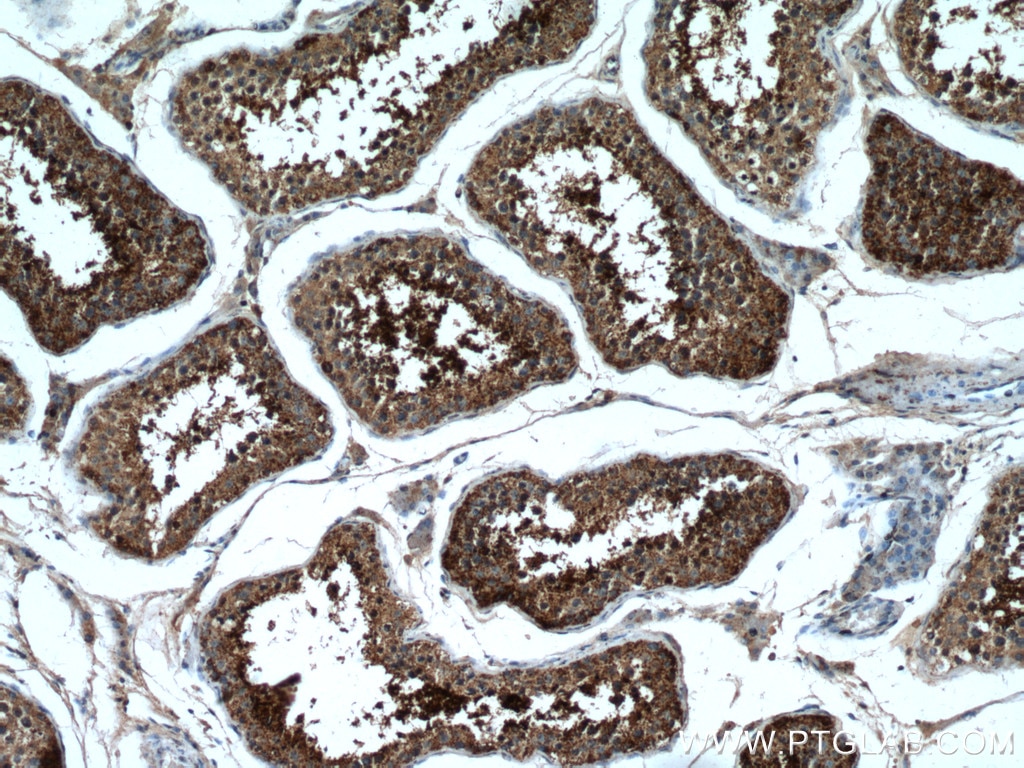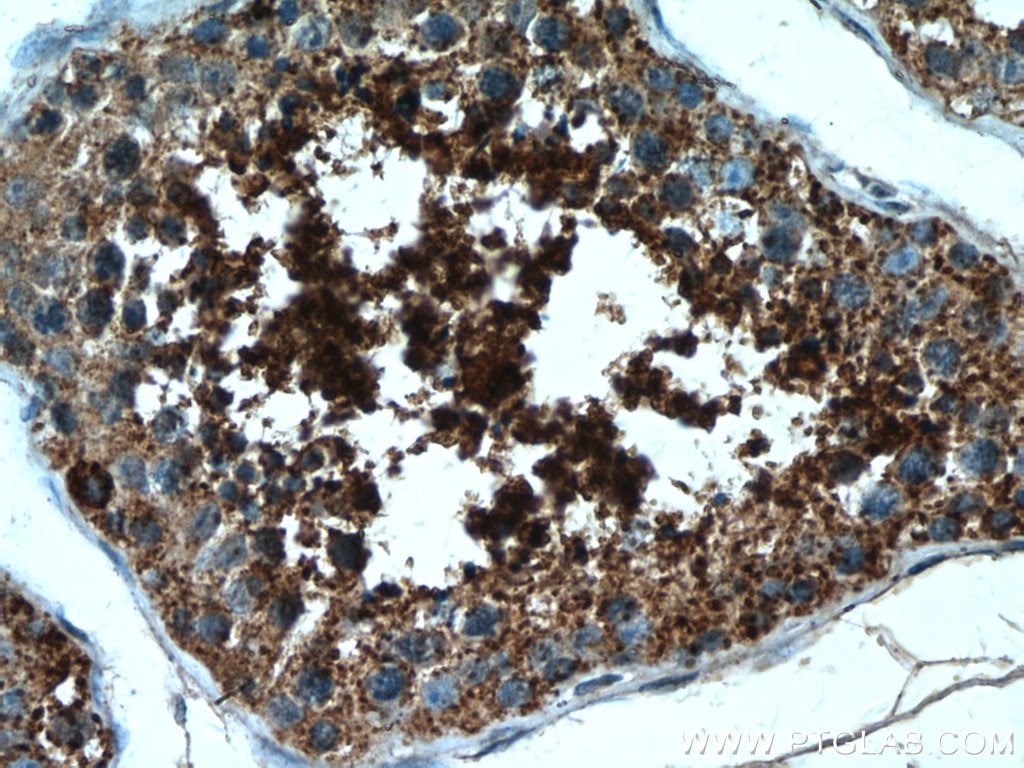HSL Polyklonaler Antikörper
HSL Polyklonal Antikörper für IHC, WB, ELISA
Wirt / Isotyp
Kaninchen / IgG
Getestete Reaktivität
Hausschwein, human, Maus
Anwendung
WB, IP, IHC, IF, ELISA
Konjugation
Unkonjugiert
Kat-Nr. : 17333-1-AP
Synonyme
Galerie der Validierungsdaten
Geprüfte Anwendungen
| Erfolgreiche Detektion in WB | Maus-Fettgewebe, Hausschwein-Fettgewebe |
| Erfolgreiche Detektion in IHC | humanes Hodengewebe Hinweis: Antigendemaskierung mit TE-Puffer pH 9,0 empfohlen. (*) Wahlweise kann die Antigendemaskierung auch mit Citratpuffer pH 6,0 erfolgen. |
Empfohlene Verdünnung
| Anwendung | Verdünnung |
|---|---|
| Western Blot (WB) | WB : 1:1000-1:8000 |
| Immunhistochemie (IHC) | IHC : 1:50-1:500 |
| It is recommended that this reagent should be titrated in each testing system to obtain optimal results. | |
| Sample-dependent, check data in validation data gallery | |
Veröffentlichte Anwendungen
| WB | See 14 publications below |
| IHC | See 2 publications below |
| IF | See 2 publications below |
| IP | See 1 publications below |
Produktinformation
17333-1-AP bindet in WB, IP, IHC, IF, ELISA HSL und zeigt Reaktivität mit Hausschwein, human, Maus
| Getestete Reaktivität | Hausschwein, human, Maus |
| In Publikationen genannte Reaktivität | human, Hausschwein, Maus |
| Wirt / Isotyp | Kaninchen / IgG |
| Klonalität | Polyklonal |
| Typ | Antikörper |
| Immunogen | HSL fusion protein Ag11360 |
| Vollständiger Name | lipase, hormone-sensitive |
| Berechnetes Molekulargewicht | 117 kDa |
| Beobachtetes Molekulargewicht | 84 kDa |
| GenBank-Zugangsnummer | BC070041 |
| Gene symbol | LIPE |
| Gene ID (NCBI) | 3991 |
| Konjugation | Unkonjugiert |
| Form | Liquid |
| Reinigungsmethode | Antigen-Affinitätsreinigung |
| Lagerungspuffer | PBS mit 0.02% Natriumazid und 50% Glycerin pH 7.3. |
| Lagerungsbedingungen | Bei -20°C lagern. Nach dem Versand ein Jahr lang stabil Aliquotieren ist bei -20oC Lagerung nicht notwendig. 20ul Größen enthalten 0,1% BSA. |
Hintergrundinformationen
LIPE, also known as HSL and LHS, belongs to the 'GDXG' lipolytic enzyme family. In adipose tissue and heart, it primarily hydrolyzes stored triglycerides to free fatty acids, while in steroidogenic tissues, it principally converts cholesteryl esters to free cholesterol for steroid hormone production. LIPE has two isoforms with the molecular mass of 117 kDa and 84 kDa.
Protokolle
| Produktspezifische Protokolle | |
|---|---|
| WB protocol for HSL antibody 17333-1-AP | Protokoll herunterladen |
| IHC protocol for HSL antibody 17333-1-AP | Protokoll herunterladen |
| Standard-Protokolle | |
|---|---|
| Klicken Sie hier, um unsere Standardprotokolle anzuzeigen |
Publikationen
| Species | Application | Title |
|---|---|---|
Ecotoxicol Environ Saf Paternal cadmium exposure affects testosterone synthesis by reducing the testicular cholesterol pool in offspring mice | ||
Int J Biol Sci LAMC1-mediated preadipocytes differentiation promoted peritoneum pre-metastatic niche formation and gastric cancer metastasis. | ||
Biochim Biophys Acta Mol Cell Biol Lipids DECR1 directly activates HSL to promote lipolysis in cervical cancer cells. | ||
Biochim Biophys Acta Mol Cell Biol Lipids PLK1 promotes cholesterol efflux and alleviates atherosclerosis by up-regulating ABCA1 and ABCG1 expression via the AMPK/PPARγ/LXRα pathway | ||
Epigenetics Differential regulatory roles of microRNAs during intramuscular adipogenesis in Chinese Guizhou Congjiang Xiang pigs. | ||
Food Funct Gentisic acid prevents diet-induced obesity in mice by accelerating the thermogenesis of brown adipose tissue. |




